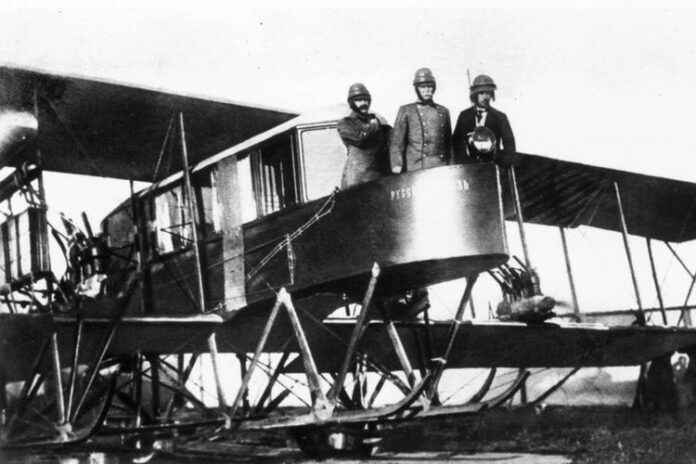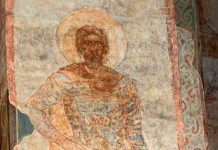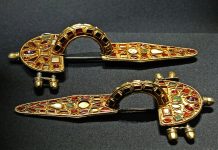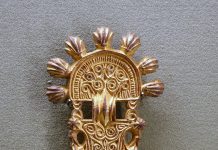“The general idea of a large flying ship with several motors, and comfortable closed cabins, had been an ideal for a long time, but none had been designed. It was in December, 1911, after the successful work of transforming the S-6 into the S-6-A, that I started actual calculations, drawings and even full size lay-outs of a large aeroplane with four motors. In February, 1912, the S-6-A received the highest award in the Moscow aircraft exhibition. During the following spring I completed negotiations, and entered into an agreement with the Russian Baltic Railroad Car Factory. The contract included the sale of exclusive design rights on the S-6-A and all other designs and inventions in aviation that I had, as well as the ones that would be made during the five years to come. It further gave me the position of designer and chief engineer of the aircraft factory’ of the company. In addition to a salary and royalties, the contract stipulated my right to build not less than one experimental aeroplane of a new type every year, at the expense of the company. It was understood that I would move to Petrograd within two weeks and would assume my new duties…
Tired and somewhat frozen, but well satisfied with my first night flight which had been accomplished in rough -weather, I returned to our hangar and there received a message that included an invitation to dinner by the Chairman of the Board of the Russian Baltic Company. I just had time to change my flying-suit and start for this dinner-party, little realizing at that moment that this evening would have fundamental consequences for my whole life… The person to whom I am referring was Mr. Shidlovsky, himself a large stockholder in the company…
After dinner, Mr. Shidlovsky and I went to his study where I made a brief report of the situation with respect to the air meet. The subject proved to be of little interest to my host and so I made my story short. There was silence while we drank black coffee which we both liked and, feeling that my chief was not inclined to discuss business, I changed the subject and briefly outlined a few of my general ideas on the subject of the future of aviation. I mentioned that the aero¬ plane of the future must be much larger in size, weight and power, must be designed along different lines, and would prove to be much more successful and more reliable than small, single-engined planes. When I stopped my host suggested that I continue my story. I went on describing in more detail the characteristics of the air giants of the future; the necessity of several motors, one independent of the other, as the only protection from hazards of forced landing in case of engine failure which was so frequent at that time; the importance of a crew of several men who would assist and relieve each other and fulfil the duties of the pilot at the control wheel, the navigator, the mechanic and others. To enable them to perform their duties properly, a large, comfortable closed cabin was necessary, particularly in the severe climate of Russia. The characteristics of such a flying ship would be such as to allow the crew to reach the motors in flight for inspection and minor repairs. During this discussion I stopped once in a while, but each time Mr. Shidlovsky would urge me to continue with more details. Encouraged, I went more to the point and informed him that for more than one year I had been working on the actual plans of a plane with four motors, a closed cabin and various other new characteristics. I pointed out that no such ship had ever been successfully produced and that the idea was condemned as impossible by many, if not by most, of the authorities on aviation. It was my firm conviction, however, that such an aeroplane could be produced and that if built and demonstrated, it would open the road to most interesting and encouraging possibilities. The conversation proved to be a long one as I explained further details and made sketches of the proposed flying ship. It was close to midnight and time to go. Thanking Mr. Shidlovsky for his kind attention, I said that the military air competition would soon be over and in the event that we won, I would suggest that the prize money be invested in the construction of such a large flying ship. His brief reply was: “Start the construction immediately.”
A quick revision of my former drawings was made in order to adjust the project to the materials that could be readily obtained in Petrograd.
…More important, however, was the progress of work on the large plane, which in November, 1912, was already well under way. It was most absorbing to watch the construction of the huge wings, particularly of the fuselage with the large, roomy cabin in the forward part. Now ideas and sketches were materializing into a flying ship which was radically different from the tiny, light planes of that time. The opinion outside the factory was mostly sceptical.
Early in 1913 the fuselage and wings were well under way and produced a substantial impression. The factory personnel started to call the new plane by a short but suitable name, “The Grand ”—in the French sense, meaning “large.” Almost every evening, when all was quiet and only a few men were around, I returned to the factory to look over the ship. While these were times of hard work and we were often busy fourteen hours a day, yet it was all extremely interesting. From thought and ideas to sketches, preliminary calculations, then to actual analysis and blueprints, and now to the huge impressive parts of the first four-engined flying ship!
… In April the parts of the “ Grand ” were transported to the military field for general assembly. Soon afterwards we had the satisfaction and thrill of seeing the “ Grand ” fully assembled for the first time…
The “ Grand ” weighed gross about 9,000 pounds. It had a span of ninety-two feet and was powered by four 100 h.p., four-cylinder, water-cooled Argus motors. Besides the size and general arrangement, substantially novel ideas were incorporated in the pilot’s and passenger cabins. The front part was occupied by a large balcony; next came the closed pilot’s cabin with two seats, double control and all flying instruments. A door in front permitted stepping out on the balcony, while the rear door would open into the main passenger cabin. The latter was luxuriously decorated, had four seats, a small sofa and a table. There was full standing room everywhere. A continuous row of large windows gave the cabin excellent visibility. In the rear was a washroom and a cabinet for clothing. Imagination had obviously entered into this fuselage design. It was like something out of Jules Verne though not so impractical. The completed plane attracted considerable interest and as the time of the test flight approached, there was usually a large crowd watching the “ Grand.” It took a few more days to test the engines and adjust the controls and mechanisms. To do this it was necessary to get the plane out of the hangar, which in turn increased the crowd. People on the field were betting whether the plane would rise; if so, whether it would crash during the landing, and there was much excitement as the zero hour approached…
Finally, late in the afternoon of May 13, 1913, the “ Grand ” was ready to fly. The Army airport was occupied by some groups that were flying, and we were asked not to make test flights during this day. Around nine o’clock in the evening, I made arrangements for the next day, expecting to leave early. I was tired and had no intention of doing much that evening. I remained on the field, however, to watch for a while the last Army ship land and taxi to its hangar on the opposite side. When I was ready to go, I was approached by Mr. Shidlovsky, who told me that the field was now free. He further mentioned that unless I was worried or indisposed to fly on the 13th, he saw no reason why the big plane could not be tested that evening. To confess the truth, I was not anxious to fly the ship then, but I could not say so, and therefore I ordered the big plane out of the hangar. It was about ten o’clock when the “ Grand ” was pushed towards the beginning of the runway. In Petrograd at that time of the year there are what are called “white nights,” which means that it is never entirely dark, and for another hour or so light would be plentiful…
Parallel to the runway at the edge of the field on a high embankment a huge crowd had collected during the last few evenings. The size and the unconventional appearance of the plane created some interest and excitement. The people were usually very orderly and never invaded the runway. That evening, however, after the first flight of the “ Grand,” it was different’ A few moments after landing we glanced through the window and saw in the dusk that the whole borderline of the field was moving like a tide towards the plane. Thousands upon thousands of men were running towards the ship and a moment later the “ Grand ” was surrounded by the crowd, roaring and shouting their joy. All three of us stepped out on the balcony waving our hands and hats, thanking them for this unprepared and sincere expression of approval and enthusiasm.”
Igor Sikorsky: ‘My family is of purely Ukrainian origin’. Official Document >










